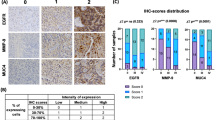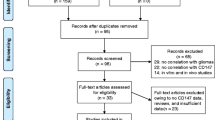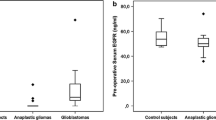Abstract
Recently, neutrophil gelatinase-associated lipocalin (NGAL) and its cell surface receptor, NGALR, have been shown to have critical roles in the biology of various tumors. Therefore, we investigated the expression of NGAL and NGALR in tumor sections obtained from patients with gliomas, and compared these results with the clinical characteristics of the patients. Using immunohistochemical assays, the expression levels of NGAL and NGALR were found to be up-regulated in tumor tissues, and to be related to tumor grade (p < 0.001). A positive correlation between expression of the two markers was also observed in these assays (r = 0.849; p < 0.001). Overexpression of NGAL and NGALR in glioma tissues was also confirmed in western blot analysis and real-time quantitative RT-PCR assays. Furthermore, overexpression of NGAL and NGALR was found to be significantly associated with poor prognosis (p < 0.001 in each case). Multivariate analysis identified patient age, tumor grade, and expression levels of NGAL and NGALR to be independent prognostic factors. In particular, NGAL(2+)/NGALR(2+) tissues were associated with lower rates of survival (risk ratio, 1.378; 95% CI, 1.102–1.724; p = 0.005). These findings suggest that NGAL and NGALR expression are frequently up-regulated in gliomas, and are closely associated with poor clinical outcome.





Similar content being viewed by others
References
Louis DN, Ohgaki H, Wiestler OD et al (2007) The 2007 WHO classifcation of tumours of the central nervous system. Acta Neuropathol 114:97–109
Deangelis LM (2001) Brain tumors. N Engl J Med 344:114–123
Flower DR (1996) The lipocalin protein family: structure and function. Biochem J 318:1–14
Goetz DH, Holmes MA, Borregaard N, Bluhm ME, Raymond KN, Strong RK (2002) The neutrophil lipocalin NGAL is a bacteriostatic agent that interferes with siderophore-mediated iron acquisition. Mol Cell 10:1033–1043
Yang J, Goetz D, Li JY et al (2002) An iron delivery pathway mediated by a lipocalin. Mol Cell 10:1045–1056
Bolignano D, Donato V, Lacquaniti A et al (2010) Neutrophil gelatinase-associated lipocalin (NGAL) in human neoplasias: a new protein enters the scene. Cancer Lett 288:10–16
Xu S, Venge P (2000) Lipocalins as biochemical markers of disease. Biochim Biophys Acta 1482:298–307
Devireddy LR, Gazin C, Zhu X, Green MR (2005) A cell-surface receptor for lipocalin 24p3 selectively mediates apoptosis and iron uptake. Cell 123:1293–1305
Richardson DR (2005) Molecular mechanisms of iron uptake by cells and the use of iron chelators for the treatment of cancer. Curr Med Chem 12:2711–2729
Kaplan J (2002) Mechanisms of cellular iron acquisition: another iron in the fire. Cell 111:603–606
Hung YC, Huang GS, Lin LW, Hong MY, Se PS (2007) Thea sinensis melanin prevents cisplatin-induced nephrotoxicity in mice. Food Chem Toxicol 45:1123–1130
Mori K, Lee HT, Rapoport D et al (2005) Endocytic delivery of lipocalin-siderophore-iron complex rescues the kidney from ischemia-reperfusion injury. J Clin Invest 115:610–621
Bauer M, Eickhoff JC, Gould MN, Mundhenke C, Maass N, Friedl A (2008) Neutrophil gelatinase-associated lipocalin (NGAL) is a predictor of poor prognosis in human primary breast cancer. Breast Cancer Res Treat 108:389–397
Iannetti A, Pacifico F, Acquaviva R et al (2008) The neutrophil gelatinase-associated lipocalin(NGAL), a NF-kappaB-regulated gene, is a survival factor for thyroid neoplastic cells. Proc Natl Acad Sci USA 105:14058–14063
Kubben FJ, Sier CF, Hawinkels LJ et al (2007) Clinical evidence for a protective role of lipocalin-2 against MMP-9 autodegradation and the impact for gastric cancer. Eur J Cancer 43:1869–1876
Zhang H, Xu L, Xiao D et al (2007) Upregulation of neutrophil gelatinase-associated lipocalin in oesophageal squamous cell carcinoma: significant correlation with cell differentiation and tumour invasion. J Clin Pathol 60:555–561
Cui L, Xu LY, Shen ZY et al (2008) NGALR is overexpressed and regulated by hypomethylation in esophageal squamous cell carcinoma. Clin Cancer Res 14:7674–7681
Fang WK, Xu LY, Lu XF et al (2007) A novel alternative spliced variant of neutrophil gelatinase-associated lipocalin receptor in oesophageal carcinoma cells. Biochem J 403:297–303
Hutterer M, Knyazev P, Abate A et al (2008) Axl and growth arrest-specific gene 6 are frequently overexpressed in human gliomas and predict poor prognosis in patients with glioblastoma multiforme. Clin Cancer Res 14:130–138
Remmele W, Schicketanz KH (1993) Immunohistochemical determination of estrogen and progesterone receptor content in human breast cancer. Computer-assisted image analysis (QIC score) versus subjective grading (IRS). Pathol Res Pract 189:862–866
Bratt T (2000) Lipocalins and cancer. Biochim Biophys Acta 1482:318–326
Sheng Z, Wang SZ, Green MR (2009) Transcription and signalling pathways involved in BCR–ABL-mediated misregulation of 24p3 and 24p3R. EMBO J 28:866–876
Bolignano D, Donato V, Coppolino G et al (2008) Neutrophil gelatinase-associated lipocalin (NGAL) as a marker of kidney damage. Am J Kidney Dis 52:595–605
Devarajan P (2008) NGAL in acute kidney injury: from serendipity to utility. Am J Kidney Dis 52:395–399
Stoesz SP, Friedl A, Haag JD, Lindstrom MJ, Clark GM, Gould MN (1998) Heterogeneous expression of the lipocalin NGAL in primary breast cancers. Int J Cancer 79:565–572
Smith ER, Manfredi M, Scott RM, Black PM, Moses MA (2007) A recurrent craniopharyngioma illustrates the potential usefulness of urinary matrix metalloproteinases as noninvasive biomarkers: case report. Neurosurgery 60:E1148–E1149 (Discussion E1149)
Smith ER, Zurakowski D, Saad A, Scott RM, Moses MA (2008) Urinary biomarkers predict brain tumor presence and response to therapy. Clin Cancer Res 14:2378–2386
Acknowledgments
We thank Shao-Hong Wang, Xiu-E Xu and Xiao-Fen Zhan for technical assistance, and Qing Zhao for data management. This study was supported by grants from the National High Technology Research and Development Program of China 863 Program grant (2006AA02A403); National Natural Science Foundation of China grants (30672376) and Guangdong Scientific Fund Key Items grants (7118419). The authors have no personal financial or institutional interest in any of the drugs, materials, or devices described in this article.
Author information
Authors and Affiliations
Corresponding authors
Additional information
Ming-Fa Liu and Tao Jin contributed equally to this work.
Electronic supplementary material
Below is the link to the electronic supplementary material.
11060_2010_486_MOESM1_ESM.tif
Fig. 6 A Kaplan–Meier plot showing the relationship between NGAL protein expression and the survival of patients. The results showed that there was no statistically significant in each subgroup (TIFF 2334 kb)
11060_2010_486_MOESM2_ESM.tif
Fig. 7 A Kaplan–Meier plot showing the relationship between NGALR protein expression and the survival of patients. The results showed that NGALR expression appeared to be prognostic only in grade I–II (a) (TIFF 2334 kb)
Rights and permissions
About this article
Cite this article
Liu, MF., Jin, T., Shen, JH. et al. NGAL and NGALR are frequently overexpressed in human gliomas and are associated with clinical prognosis. J Neurooncol 104, 119–127 (2011). https://doi.org/10.1007/s11060-010-0486-0
Received:
Accepted:
Published:
Issue Date:
DOI: https://doi.org/10.1007/s11060-010-0486-0




